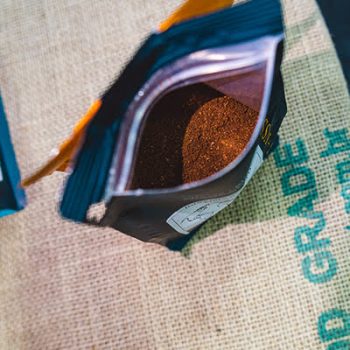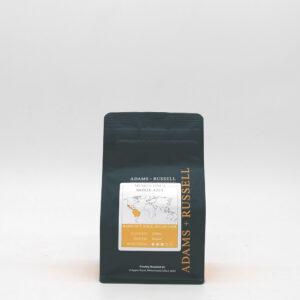Buying Single Origin Coffee in the UK & How it’s different to blend Coffee
- Updated on: March 7, 2024
- Written by: Aimee Bennett
Aimee is a coffee enthusiast and has worked in the coffee industry for years. She sources coffee beans from around the world and her coffee journey began in… (read more).

Coffee beans are produced at many different kinds of estates all over the world, primarily in a huge swathe of the Southern hemisphere called ‘the bean belt.’
The local climate, soil, flora and fauna, growing techniques and genetic heritage of a bean all have an impact on its flavour.
But so do the approaches taken to how it is packaged and produced after the harvesting has taken place.
Once harvested and prepared, if the beans are then mixed with those from other countries and/or estates the coffee is known as ‘blended’, whereas if it is kept pure, it is called ‘single origin.’
In this article we take a look at the main characteristics of single origin products and discuss a few of their major features.
What is single origin coffee?
Basically, a simple definition is coffee that is produced in a single geographic region.
This region could refer to an individual farm or estate, a local county or principality, or even a whole country – but the beans must come from only this location and not be mixed with other products at any stage.
Coffee from a single origin will usually be a single type of bean too, as opposed to a mixture from various different trees grown in the same place.
Sometimes you’ll also see labels that explain the product is ‘single farm’ or ‘single estate’ – meaning the beans have been produced by one business and/or in one location.
In addition, it is also possible to go super-specific and purchase ‘microlot’ coffee – which is made from beans produced by a select few trees in a single location that have been singled out for their quality or uniqueness by the farmer.
As an analogy – imagine a vineyard owner separating the grapes from a select group of their highest quality vines and creating a wine from them with a different name, and a higher price.
What’s the differences between single origin and blend coffee
Blended of ‘blend’ coffee products made up of beans from several regions or countries are very common types of beverage available in shops and cafes all over the world.
Blended coffees can differ from single origin products due to the range of flavours on offer and the longevity, strength and characteristics of the final product.
Another major difference between single origin and blend coffee is that blended coffee can be produced in higher volumes all year round.
This is because single origin coffee production will vary according to the season of the location – so there will be periods of time where output is much slower, or even stopped completely.
A blended coffee can substitute similar beans from a different location when one of its origins is out of season. This enables the producer to maintain production and possible offer a lower price.
Yes, this can cause seasonal variations in flavour, but the differences are usually quite minor as the replaced beans are just one of a number of constituents.
Coffee blends usually contain beans from two to four different plantations which gives them the more complicated flavour profile, and these can even be in different countries.
A single origin coffee has a more defined flavour which enables the consumer to experience the real taste of the region.
Key single origin coffee characteristics
Coming from just one location, coffee from a single origin is the ideal way to really assess the taste and strength of a particular type of bean.
Single origin coffee is the most intense and consistent way to try out a new flavour as it isn’t affected by beans from other places.
For this reason, real aficionados often have their single origin brewed black, in order to taste the beans in their purest form.
As mentioned, as single origin coffee is made up of just one type of bean the flavour profile is less complex than blended versions, and this can stand out even further without milk or cream.
The beans need to stand up on their own, there is no diluting or altering the primary flavour that comes with mixing different flavours and textures.
For this reason coffee of a single origin is also often a higher quality – if the producer can’t rely on mixing the beans to improve the flavour, strength, longevity or other characteristics of the beverage; they must have real confidence in the product.
This also makes the strength of the coffee consistent and predictable, whereas sometimes blended versions may have a small range.
The best single origin coffee from around the world
Choosing the best coffee in any category is always a difficult challenge. Everyone’s tastes and tolerance are different and we all like to make and enjoy our drink in our own way.
Beans from just one origin can be used in a variety of different preparation processes, and their consistent and defined taste mean this a great opportunity to try out different techniques to get the most out of the product.
You also need to make sure that you choose the right roast level for the bean. Blends can have a greater acceptable roasting range due to the mixture of different texture beans.
We’ve produced a chart showing 24 of the world’s best single origin coffees along with notes on the flavour characteristics and the recommended roast type for each.
You might be in the mood for the cocoa hints of an East Timor product for example – and to drink it as the producer intends you should go for a dark roast.
Or perhaps the toasted nuts and caramel flavours of a single origin Colombian coffee is more to your taste – in this case you should ideally choose a medium roast to fully appreciate the quality.
When all of the beans have come from a single location there is nowhere for the flavour to hide, so make sure you do the product justice by selecting the right roast to match the profile.
A growing phenomenon
As we enter 2020, consumers are a lot more conscious of where their food and beverages come from these days.
There is a growing international market for products that are ethically and sustainably sourced – where care has been taken to ensure environmentally-friendly ingredients and production methods, and fair deals for suppliers have been made.
To prove these qualities, traceability is very important in the industry – global supply chains can make it difficult for end-users to track where all of the different ingredients of a more complex product, such as blended coffee, might originate from.
This makes single origin beans very attractive for many consumers – knowing exactly where your beverage is from, and dealing with companies that are transparent about their suppliers, enables customers to make better informed choices.
Interestingly, the increased demand for single origin and specialty coffee is also having an effect on farming processes on the ground.
New tastes and market forces are causing producers to adjust how they grow, harvest and prepare beans to meet the needs of modern consumers.
Single origin coffees can be a real source of pride for farmers. When they know their produce isn’t going to be mixed with other beans to develop a finished coffee product, they can focus on creating the best possible crop.
Beans from a single origin offer a real taste experience for the coffee fan interested in getting an authentic understanding of the flavours of a particular location.
And as they can also be traced to sustainable, ethical and innovative sources; they help everyone make better choices while also finding great-tasting brews.





